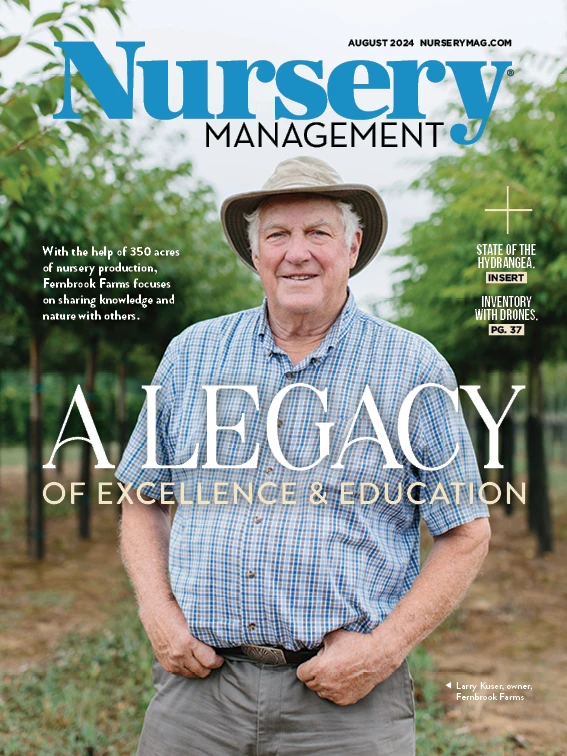
Photos by Endless Summer Hydrangeas
The month of August in Winterville, Georgia, is hot and humid. While it may not be an ideal time to evaluate Hydrangea macrophylla blooms, it’s an incredibly important month for the plant breeders at Bailey Innovations. For those of us in Georgia, August is past the point of “peak bloom” for many H. macrophylla varieties, but for remontant or reblooming cultivars, the party’s just getting started. The plant breeding staff at Bailey Innovations trial hundreds of new H. macrophylla accessions (individuals) each year, and August is when we learn which of our selections rebloom to our expectations and which don’t make the cut. By observing the flower power and subsequent rebloom of our hydrangea, we can make informed decisions for potential introductions.

To better understand how we evaluate remontancy and rebloom, we need to get a few definitions out of the way. Remontant is derived from the French word remonter, meaning “to rise again.” In our modern lexicon, remontant refers to a plant capable of flowering multiple times or reblooming throughout a growing season. While rebloom can mean different things to different plants, we’ll focus on how we define remontancy and rebloom in H. macrophylla. At Bailey Innovations, we consider remontancy to reflect a hydrangea’s ability to set flower buds on the previous season’s growth (old wood) and the current season’s growth (new wood). This phenomenon is highly valued in the world of ornamental plant breeding, and it’s easily one of the most important aspects of our hydrangea evaluations. However, it’s not a simple matter of saying a plant either has remontancy or doesn’t. Through our annual trials, we’ve learned that even though a hydrangea can be remontant, there’s no guarantee that plant will be a good rebloomer.

Why are reblooming hydrangeas all the rage? Well, who wouldn’t want a natural extension of a plant’s flowering window? Roses are well known for this trait, but H. macrophylla are quickly becoming the standard for repeat blooming shrubs. The ability to flower on the current season’s growth, or new wood, provides several benefits in the garden. In colder, northern climates, H. macrophylla are only stem hardy to a point. Once you dip into negative digits, most will experience total stem death. The roots and crown may survive, but if you’re growing a non-reblooming H. macrophylla in Minnesota, you’ll likely never see any blooms because all the flower buds on the old wood are killed.
A similar challenge occurs in southern climates that experience early springs and late frosts. In Georgia, our plants will often start growing in late February or early March. Inevitably, we experience a late frost, which damages or potentially destroys flower buds on old wood. With reblooming hydrangea, these issues can be sidestepped thanks to the plant’s ability to flower on new wood. Did you lose all your stems to -30°F? No problem; you’ll get flower buds in the spring when the new shoots emerge. Did a late frost set back your plant’s development? Don’t stress; you’ll get flowers on your next flush. One of the greatest benefits reblooming hydrangea provide are their ability to take the guesswork out of pruning. We’ve all heard you must be careful when cutting back hydrangea, but with reblooming cultivars, you can cut the stems back any time of the year and still get flowers the following season.

As mentioned, you can have a remontant plant that isn’t necessarily a great rebloomer. Even two plants derived from the same parents can drastically differ in rebloom. Remontancy is such an important characteristic for H. macrophylla that we spend years trialing our plants to determine which ones have the best performance. If a hydrangea makes it to the second year of evaluations, we’ll cut the plants back hard in mid-June to remove pre-existing flower buds and force the plants to push vegetative new growth. If a hydrangea flowers on that new growth, we consider the plant to be reblooming. This pruning practice gives us a glimpse into the plant’s potential. Those plants that perform best in our second-year cutback evaluations might graduate to our rebloom trials, where we put selections through real-world production scenarios.
Once a selection graduates from our rebloom trials, it moves to other Bailey locations for continued trialing. In Minnesota, our hydrangeas are planted in fully exposed trial rows where we learn whether our selections have enough cold tolerance and remontancy to perform well in northern climates. We send our selections to evaluation partners in as many regions as possible.

Explore the August 2024 Issue
Check out more from this issue and find your next story to read.
Latest from Nursery Management
- John Ruter shares UGA's latest woody and herbaceous ornamental plant breeding projects
- Conor Foy joins EHR's national sales team
- Pantone announces its 2026 Color of the Year
- Syngenta granted federal registration for Trefinti nematicide/fungicide in ornamental market
- Get to know Kayela Aeppli
- HILA 2025 video highlights: John Gaydos of Proven Winners
- Q&A with Justin Bartlett
- Be the best choice





